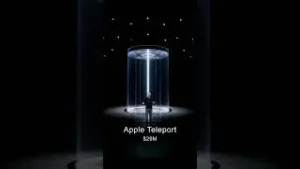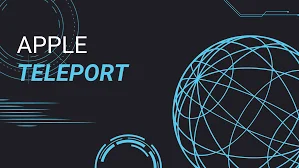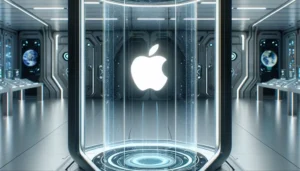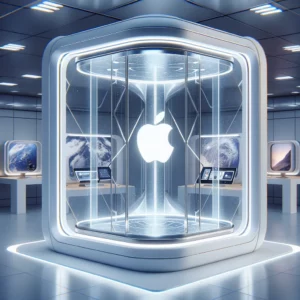Introduction: The Day Apple Announced Teleportation
When Apple steps on stage to announce something new, the world pays attention. For decades, the company has redefined industries—computing, music, smartphones, wearables, and even digital payments. But when the rumors of Apple Teleport began circulating, nobody quite knew what to expect. Could the same company that put a supercomputer in our pockets now put the entire planet within walking distance—literally?
The first unveiling was a blend of showmanship and shock value. Tim Cook stood in front of a giant projection of the Earth, grinned, and said, “The most powerful thing we’ve ever made isn’t a device—it’s a way to move you anywhere in the world, instantly.” Gasps, camera flashes, and whispered disbelief filled the venue. This wasn’t just a new iPhone—it was an entirely new category of human experience.
From that moment on, Apple Teleport wasn’t just a piece of tech; it was a cultural milestone. The device promised to collapse time and space, offering people the ability to commute across continents in seconds, visit family halfway around the world before breakfast, or turn vacations into afternoon getaways. And, as always with Apple, the pitch wasn’t just about what it could do—it was about how seamless, safe, and elegant it would feel.
The Concept Behind Apple Teleport
Teleportation has been a staple of science fiction for decades. From Star Trek’s transporters to comic-book heroes with space-warping powers, the idea has always lived in our collective imagination. The challenge has always been that, in reality, moving matter instantly from one place to another isn’t exactly easy—physics, quantum mechanics, and energy constraints all stand in the way.
Apple’s approach, at least according to their carefully worded announcements, combined quantum entanglement with matter reconstruction algorithms. In simple terms, the Teleport scans every atom in your body at a subatomic level, encodes that information securely, and reconstructs you at your chosen destination using advanced matter printers. The transmission happens over Apple’s proprietary “Quantum Link Network” (QLN), which they claim is faster than light for data transfer.
While the science sounds intimidating, Apple made it sound… well, like Apple. Their marketing pitch reduced it to three steps:
-
Step onto the Teleport Pad.
-
Pick your destination on your iPhone.
-
Arrive instantly.
It’s the kind of simplification that made complex technologies like the internet, GPS, and AI feel like everyday tools. Behind the simplicity, though, lies one of the most advanced technological feats in human history.

The Design: Minimalism Meets Quantum Physics
Apple has always been as much about design as about technology, and Apple Teleport is no exception. The first model, Apple Teleport Pro, looks like a sleek circular platform, about the size of a large rug, with a shimmering glass-like surface that glows when activated. Around the edges, subtle white lights shift in soft patterns, signaling the system’s readiness.
The interface is handled through an updated iOS Teleport app, preloaded on all new devices. You can browse destinations, check real-time travel queues, and even preview the arrival environment via live AR feed. For security, teleportation requires Face ID authentication plus a real-time biometric scan on the platform.
In typical Apple fashion, the hardware feels like a luxury item—polished aluminum edges, glass surfaces resistant to scratches, and an almost futuristic hum when powered on. The Teleport Pad also integrates seamlessly with your smart home, syncing with Apple HomeKit to adjust lighting, send alerts to loved ones when you arrive somewhere, and even preheat your smart oven for dinner the moment you step back from Tokyo or Paris.
How It Works: The Magic Under the Hood
Explaining teleportation technology to the public without diving into terrifyingly complex physics is a challenge. Apple’s engineering team, however, managed to break it down into three main processes: Scan, Transmit, and Rebuild.
-
Scan – Using advanced quantum sensors, the Teleport maps every molecule of your body. This isn’t just a surface scan—it captures your cellular structure, neural patterns, and even the state of your immune system in real-time.
-
Transmit – The encoded data travels through the Quantum Link Network, an infrastructure Apple claims is “the largest leap in communication since the internet.” Instead of traditional bits, the system uses quantum states, allowing instantaneous transmission over vast distances.
-
Rebuild – At your destination, a network of Apple-certified matter reconstruction units (MRUs) reassemble you atom-by-atom, restoring not only your body but your consciousness in perfect continuity.
It’s worth noting that while the technology sounds like something ripped from a sci-fi blockbuster, Apple insists it’s built with redundant safety protocols. If any part of the data transmission is incomplete, the teleportation is halted before you ever leave the pad—meaning there’s no “half-teleport” horror stories.
Everyday Life with Apple Teleport
The moment Apple Teleport became available to the public, daily life began to shift. Commuters in major cities no longer faced two-hour drives or train rides. Families separated by continents could meet for dinner without booking a flight. Students could attend lectures in London in the morning and study at a beach in Bali in the afternoon.
The work-from-home revolution took another giant leap—now it became work-from-anywhere. Imagine working from your favorite coffee shop in Rome before heading back to New York for an evening concert. For businesses, Apple Teleport meant drastically reduced travel budgets, instant access to global talent, and the elimination of timezone barriers for face-to-face meetings.
Even leisure changed. Tourism skyrocketed as barriers like airfare, jet lag, and vacation days became less relevant. Weekend trips now included destinations that once took days to reach. And with Apple’s environmental messaging, teleportation was marketed as an eco-friendly alternative to carbon-heavy air travel.

The Security and Privacy Questions
Of course, not everyone greeted Apple Teleport with unreserved excitement. The technology raised enormous security and privacy questions. When a machine disassembles you atom-by-atom and sends your molecular blueprint across a network, people want to know: Who else can see that data? Could it be hacked? Could someone… clone you?
Apple responded predictably—with reassurances about end-to-end quantum encryption, hardware-based privacy features, and government-grade security compliance. They claimed all teleportation data is destroyed immediately after successful reassembly, and no raw biological data is stored. Independent security audits (some public, some behind closed doors) have so far supported Apple’s claims.
Still, skeptics worry. Digital breaches are common enough—what happens when the stakes are not stolen passwords but stolen identities in the most literal sense? Apple’s answer is that the QLN is “unhackable by design,” but history has taught us that no system is entirely immune to exploitation.
The Economics of Instant Travel
Teleportation didn’t just change the way we move—it changed the way money moves. Initially, Apple Teleport Pro was priced at a luxury level—$149,999 for the home unit, plus $99 per teleportation for domestic trips and $299 for international. But just like with the iPhone, economies of scale began to kick in, and prices steadily dropped.
Airlines, train companies, and even car manufacturers felt the impact immediately. Business-class flights saw sharp declines, and high-speed rail expansion projects were halted in some countries. In contrast, new industries sprang up around teleportation hubs—cafes, workspaces, medical facilities, and tourism services tailored for instant travelers.
Interestingly, the technology also began to redistribute wealth in subtle ways. Smaller towns with teleport hubs saw economic booms as people teleported in for events, nature escapes, or unique experiences. The “distance premium” on real estate began to collapse—living in the countryside no longer meant being far from the city.
Environmental Impact
Apple marketed Teleport as a green technology, highlighting the massive reduction in carbon emissions from traditional travel. Fewer flights meant fewer greenhouse gases, fewer ships meant less ocean pollution, and reduced car use meant cleaner cities.
However, teleportation isn’t entirely energy-free. The scanning, transmission, and reconstruction processes consume vast amounts of power. Apple claims that each teleportation’s carbon footprint is equivalent to charging an iPhone for a year—still far less than a single plane trip, but not negligible.
Environmentalists remain cautiously optimistic. If the global energy grid moves toward renewables, teleportation could become almost carbon-neutral, making it one of the most significant eco-friendly innovations of the century.
The Social and Cultural Shifts
Beyond economics and science, Apple Teleport changed human culture. Long-distance relationships became easier. Multicultural exchange flourished. Festivals, concerts, and global sporting events saw record attendance as physical barriers vanished.
On the flip side, some sociologists warn of “proximity overload.” If you can visit anyone instantly, the rarity and planning of visits might lose their emotional weight. Distance has historically shaped human relationships—now, it’s gone.
Still, for most people, the benefits outweigh the drawbacks. Families reunited, global friendships deepened, and curiosity-driven travel exploded. Humanity’s sense of the world’s size shrank to something almost intimate.

The Road Ahead
Apple Teleport is still in its infancy. Like the early days of the internet, we’re only beginning to understand its potential and consequences. Future updates promise interplanetary teleportation (starting with the Moon and Mars bases under development), medical emergency transports, and even “Teleport Memories,” allowing you to replay sensory experiences from past journeys.
Apple’s competitors are already trying to catch up, but history has shown that being first often matters more than being perfect. With Apple’s brand loyalty, ecosystem integration, and relentless refinement, it’s likely they’ll remain the leader in this new market for years to come.
For now, one thing is certain—Apple didn’t just launch a new product. They fundamentally rewrote the rules of movement, reshaping human life in ways we’re only beginning to comprehend.
